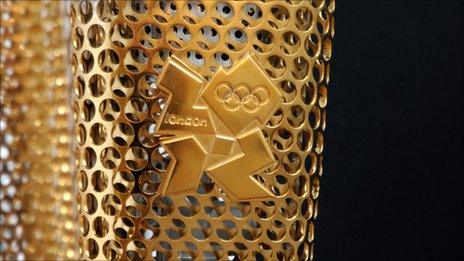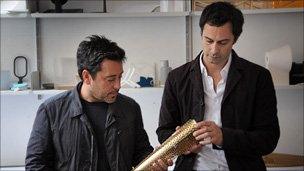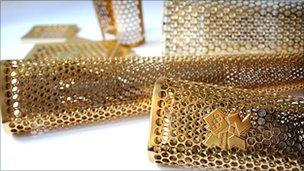London 2012: Designing an Olympic 'torch for our time'
- Published

It's golden and it's perforated. The two design elements that hit home on first laying eyes on the prototype of the London 2012 Olympic torch.
In fact there are 8,000 small, laser-cut holes in two aluminium skins that are bent around and welded together to form a tapering cone.
Each represents one of the runners who will carry the flame around the UK for 70 days from mid-May next year, on a relay that will take in about 8,000 miles.
Twist and turn it in the hand, inspect each end and it's triangular. The top is 10cm across at its apex, shrinking down to 4.5cm at the base. A three-sided torch for London's third Games.

Jay Osgerby and Edward Barber say they are looking forward to seeing the torch in action
Its shape is also inspired by the three-word Olympic motto, external set out by the founder of the modern Olympics Pierre de Coubertin - Citius, Altius, Fortius, Latin for 'Faster, Higher, Stronger'.
And it ties in with the trio of wind, fluctuating temperatures and rain which the flame itself will have to brave to stay alight on its journey.
The torch's designers - the east London partnership of Edward Barber and Jay Osgerby, external say they took their inspiration from these aspects and the desire to make something relevant for each person who will be nominated to carry the torch, external.
As a firm, Barber Osgerby is known for its industrial-style furniture design - Tip Ton Vitra tipping chairs and Tab Flos lamps; for the furniture at Bexhill's De La Warr Pavilion, external or the stainless steel front desk that greets contemporaries at RIBA, external.
Attentions at the firm - split across two floors in a low-key Shoreditch building - turned last September to what they call a "once in a lifetime project, a chance to represent our country in design terms". Taking a functional eye to something that is also ceremonial.

Foam, card and resin designs are made before the prototype is produced
As they unwrap the latest torch to join the sequence created for each Olympiad since 1936, they say they "both" designed it - a believable statement from a pair that finish each other's sentences in the mould of a classic working partnership.
"We felt it should be something that's really beautiful and simple," says Jay Osgerby of their design.
"But it had to feel like a functional object," says Edward Barber. "A piece of sporting equipment like a baton." Although it is the flame itself, not the torch, which will be passed on during the relay, as the torch tips touch in a "kiss".
Eight thousand torches will be made - one for each bearer. London 2012 Olympics organisers Locog are tight-lipped about whether people will have to buy or be given the torches, and on the cost of the torch design and manufacture.
The torch is a light one - 800g including the prototype fuel canister - and it is tall, at 80cm. Barber and Osgerby were mindful of the 12-24 year old carriers who will make up half of the bearers and the need to see smaller participants.
And what to make of the slightly 'bling' colour, unexpected from a company usually producing white and muted tones?
"The whole theme of the relay is gold, that the torch shines a light across the country," says Edward.
"It would have been really easy for us to do a steel finish and we have a tendency as a nation to be reticent," says Jay. "But this is the chance to show off and have fun."
They also wanted to try to come up with something using the latest production techniques.
"We were inspired by the engineering possibilities open to us and wanted it to be an expression of what's possible today," says Jay.
"A torch for our times," adds Edward. "We felt the best way to achieve that was to use technology and push it as much as we could."
'Flame out' fears
Their initial attempts to weather-test a home-made torch of fused plumbers' pipe, topped off with an Ikea cutlery drainer, using the office fan and a watering can, belie the technology involved here.

The latest production techniques will be used in the production of the 8,000 torches with 8,000 holes
They took the torch from foam and paper mock-ups, through printed 3-D plastic models to punctured sheets of an aluminium alloy manufactured by Coventry firm, Premier Group, external.
Eight thousand torches with 8,000 holes means 64,000,000 holes to punch and the need for a machine that can bang out 16 holes a second.
The two "skins" that form the torch are bent on a press and then welded together, the die cast top and base and 2012 logo attached, and the torches will be finished with a golden coating, possibly titanium nitride.
The burner - a propane-butane gas canister that can burn for about 10 minutes - will be dropped into the core. When it comes to the relay, these will be turned on to let the gas flow by a torch attendant before the flame is received by the bearer.
The torch is the latest visual offering from Olympics organisers who also oversaw the much-maligned 2012 logo design. Barber Osgerby are as nervous as any creator about how their design will be received.
The possibility of "flame outs", the bane of past relays, when the torch has then to be re-ignited by a back-up flame, is also keeping them awake at night.
"It's almost certainly going to happen, we just hope it's a really rare event," says Jay.
They hope that a barrage of testing, where the torch will be exposed to 75mph wind, -5C temperatures and pouring rain, will help prevent glitches.
Above all, however, they look forward to watching their design wend its way around the UK, carried and watched by thousands and culminating in lighting the Olympic cauldron at the opening of the Games.
Jay says: "We have the anticipation of the opening ceremony and watching our torch coming in. Anticipating that moment in the stadium is incredibly exciting."